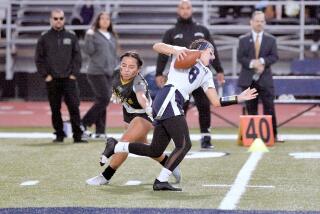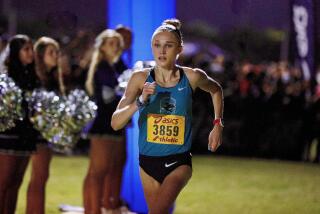WHERE’S COUNTRY IN CROSS-COUNTRY? : Changing Landscape Has Made for Faster but Less-Challenging Tests for Runners
Cross-country. The name should say it all.
Cross the fields, splash through streams. Climb over hills, duck under trees.
Watch for rocks, holes and logs, hop over snakes, rabbits and frogs.
Chug through mud, if you must, then leave your competitor in the . . .
Well, you get the idea.
In its most classic sense, cross-country, a sport that originated in the British Isles more than 150 years ago, is the survival of the fittest, toughest and most agile runners.
The cross-country course, be it grueling or only mildly challenging, should be a test of the runner’s abilities.
Until about 10 years ago, Orange County high schools offered a variety of great cross-country courses.
Not anymore.
Land development--especially in the fast-growing south county--has destroyed or set off limits many of what once were the better courses.
Though many of the present courses are faster--and today’s runners seem to be getting more and more concerned with their times--many coaches and former athletes lament the change in their sport.
Courses gave way to condos. Hills, once lined with spectators, now are lined with stacks of tract homes. Surveyors came in, and years of tradition were plowed under.
Call it the Bulldozer Invitational.
“It just kills me,” said El Toro girls’ co-coach Diane Hale, who has had to find new courses for the Chargers five times since 1980.
“We had some of the best places to run. Now we have to get in cars and drive far to find anything that’s not covered with houses. And that’s sad.”
It’s a feeling shared by many coaches, most of whom point to an apartment complex, a housing tract or a industrial park and say: “There’s where our old course used to be.”
So where have they all gone? Here’s a sampling:
Mission Viejo High School’s course behind Saddleback College. The site of the 1980 Orange County and Southern Section championships, this course included two long, steep, dirt hills that challenged the strongest runners, and rolling hills throughout.
Today, the hills are filled with apartments, and increased traffic has made alternate race courses there unsafe.
Laguna Beach’s course at Top of the World Drive. Stuart Calderwood, who ran at Laguna Beach in the late ‘70s and now coaches the Artists, called this course “the most notorious course in the county . . . It was the most hated course around.”
On the fire roads high above the Laguna Beach coastline, Top of the World included an almost non-stop supply of long, steep hills.
Eric Hulst, who set a national record of 8 minutes 44.6 seconds in the 2 mile in 1976, held the 2-mile course record at Top of the World in 11:04.
Today, Top of the World is developed on one side, fenced off on the other.
Corona del Mar’s Back Bay course. Site of the Corona del Mar Invitational for many years, this course had short, steep hills, long sandy stretches and wide-open fields--all along horse trails above Newport’s Upper Back Bay.
Each portion of the course had a name, including its two biggest hills--Big Bertha and Crash and Burn (site of a plane crash in the early ‘70s).
Today, most of the course lies under the Newport Beach Marriott Suites.
So where are most cross-country races run these days? Most schools have two choices: on campus or in a park.
There are advantages and disadvantages with each.
Most on-campus courses are just that. On campus. Meaning that, for the most part, the greatest challenge is dealing with tedious loops around the baseball field, football field and track.
Matt Simpson, Fountain Valley boys’ coach and a former runner at Loara, described Loara’s course as “around the school, totally boring, totally flat. The only hill we hit was when we went over the pitcher’s mound.”
Some coaches say that on-campus courses have their advantages. Obviously, they reduce transportation costs. But mostly, on-campus courses are more likely to bring out a student body cheering section, which, in turn, helps to create interest in the sport for recruiting purposes.
Some schools include surrounding streets and sidewalks, making the course look more like a weekend road race. In such courses, a runner’s speed--not agility, coordination or strength--is what is tested.
“It becomes a track race basically,” Canyon Coach Mike Sayward said. “Let’s face it, in Orange County more than 50% of the so-called cross-country courses are just asphalt road races.”
It’s a situation viewed one of two ways.
Some runners--especially those who have known only fast, flat courses--are satisfied with the road race-type course. At the Dana Hills Invitational last Saturday, many coaches said their runners enjoyed running there--a fast, flat, somewhat downhill course--because they could run fast times.
“It’s an ego-builder, basically,” Dana Hills girls’ Coach Ron Buchhiem said.
But others, especially those who have been in the sport for many years, say they find the trend toward this attitude disappointing.
“People forget what the point of cross-country is supposed to be,” said Sayward, a native of England, where cross-country has kept its traditional look. “We used to run on side of hills, with no paths at all, over plowed fields. It was a real doozy, running through mud, climbing over fences and little walls. The idea is, you shouldn’t be able to keep your rhythm for more than a short time.
“Running 3 miles without a hill or a change of surface, what’s the challenge in that?”
Many runners agree. Villa Park senior Laura Doering, who has competed in age-group races since she was 9, has run courses in every part of the nation. Her feeling is: the tougher, the better.
“The ideal course would have one killer hill, it would have sand, dropoffs, barriers to jump over, and mud,” she said. “It should be a challenge just to finish. Cross-country should be grueling and tough--not a track race. . . . But all people seem to worry about these days is fast times.”
Flat, fast courses also can work to a runner’s disadvantage. Some college coaches--especially those in the Midwest or Northeast--believe Southern California runners are risky recruits because they are not accustomed to the kind of challenging cross-country courses most colleges use.
Kirk Elias, assistant cross-country coach at the University of Minnesota, has recruited in the area and watched the Woodbridge Invitational Sept. 9. The course at Woodbridge is fast, flat and mostly paved.
“There were some very talented athletes there who ran very well,” Elias said. “But my thoughts were that I’m not so sure which of those athletes would adapt well to college running. Since the courses they run are mostly road-race types, it’s really tough to tell how good of a cross-country runner they really are.
“Out here (the Midwest), the terrain is softer, there’s lots of hills, the courses are uneven. Kids (in Orange County) aren’t used to that. . . . When they get to college, they could be in trouble.”
Of course, not many schools have access to a quality cross-country environment. The Garden Grove League schools, for example, are located in a densely populated, congested area.
And, because of increased transportation costs and budget restrictions, Garden Grove League coaches were given a choice 10 years ago--either run on campus or run at Mile Square Park in Fountain Valley.
They chose the park, and set up a course on the basically flat, grassy terrain. Every Thursday afternoon, all eight Garden Grove League teams meet there, and run the same course. Every Thursday, every year, the same flat 3 miles.
“It was the screwiest situation I ever saw,” said Daiva Jusionis, who coached at Pacifica for three years before taking over at Westminster this season.
“It was so boring for the kids, especially the seniors who’d been running it for four years. The only good thing was you could keep tabs on how your competition was doing.”
Irvine Regional Park in Orange, Craig Park in Brea, and Central Park in Huntington Beach also are among the county’s most-used settings for cross-country courses. But even though the parks offer nice scenery, there is a growing problem with crowds.
Central Park is used each Thursday by Ocean View, Huntington Beach or Fountain Valley. Orange Coast and Golden West colleges run there on Fridays. And invitationals are on Saturdays.
Each uses its own custom-designed course.
“It gets kind of crazy,” Fountain Valley’s Simpson said. “Everyone uses different-colored chalk to mark their course. Some use blue, some red or orange or white or yellow. Most times, there’s lines all over the place. We try to brush off the others’ colors each time we race, but you got to just hope your kids remember which line to follow.”
So what alternatives do Orange County runners have? Not many. Because of liability, large private landowners such as the Irvine Co. do not allow athletic competition on their land. Golf courses, a popular site for cross-country competition in other parts of the United States, are far too busy to accommodate cross-country races.
UC Irvine Coach Vince O’Boyle said there is a possibility of a permanent course being created on the Irvine campus in the near future. O’Boyle said he hopes it would work out like other permanent courses in the state, such as Fresno’s Woodward Park, the site of the state high school cross-country meet.
But until then . . .
“It’s run around the school or in parks,” Jeff Davis, Santa Ana coach, said. “I really don’t see another solution. Unfortunately we don’t have many philanthropists around saying, ‘I’m going to buy this huge plot of beautiful land and cross-country kids can race on it.’ ”


